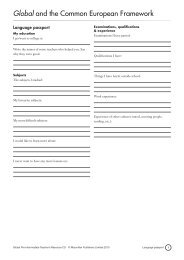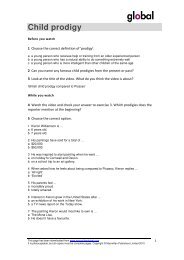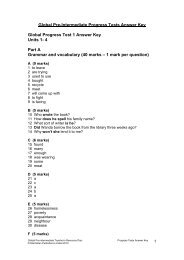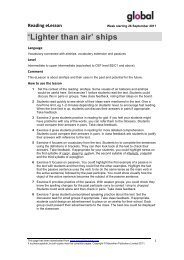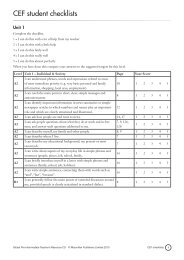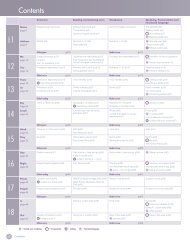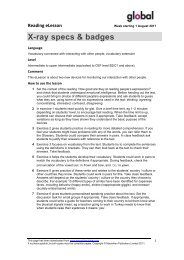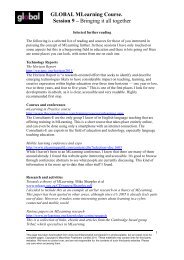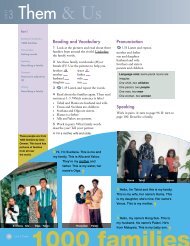UNIT4Hopes & FearsPart 1TEACH globalThink localLead-inTell students about someone who you really admire and why.Students do the same for themselves – give thinking timeand allow them to make <strong>notes</strong>. Students talk in threes. Takebrief class feedback and ask students to give reasons fortheir choice – did they choose X because of their personality,talent, money, good-looks? This requires students to considertheir personal values and links to the next stage.Vocabulary (SB page 42)1 Refer back to the reading on Dorian Gray page 33.Students tell each other in pairs what they can rememberabout the extract and the novel. Remind students that hemade the choice to stay young and good-looking overeverything else.Students read the phrases in exercise 1 and work alone toorder the qualities in order of importance.TEACH globalThink localMixed abilityAdd extra phrases on the board, giving students time to thinkwhere they would position these in order of importance: beinghappy with yourself; living in a nice,comfortable home; havinggood friends; having a loving family; having a secure jobAfter comparing answers, invite class feedback. Askstudents to try and justify their responses if they feelable to.2 First ask students to quickly look through theadjectives in the box and to tell you how many words arenew to them. If there are four new ones or more, thenelicit / clarify the meaning, so that the task is manageable.Drill the students on the new items.Pronunciation noteNote the schwa, eg /ˈeksələnt/, /ˈklevə/, /ˈhænsəm/,/ˈwʌndəfəl/, /ˈɔːfəl/. You could also highlight the silent ‘d’ in‘handsome’ and the pronunciation of the first vowel in ‘awful’.being good-looking: beautiful, handsome.being intelligent: clever, smart.being rich: wealthy, well-off.having good health: wonderful, excellent.Language noteHandsome is usually used for (adult) men, or for women witha strong face. Beautiful is usually used for women and youngchildren. Good-looking is typically used for adult men andwomen. In spoken English, good-looking is more usual thanhandsome for describing men.3 Elicit the answer as a whole class.Extra words: awful, terriblesynonym: bad4 Ask students: Do the things you want from life change asyou get older? How? Give students a personal example toshow how your own priorities have changed / will change,putting the examples on the board, using the targetphrases suggested.Students do exercise 4. Monitor and assist as students arewriting. Students then compare ideas with a partner. Pickup on any areas of interest as a whole class.Reading (SB page 42)This text is a random collection of thoughts about thefuture, expressed by young children.1 Ask students to look at the pictures and tell them theyare going to read about different children’s hopes, givenin a survey.Elicit some suggestions about the kind of hopes thesechildren might have. Ask students to read the statementsand make a choice of a, b or c. Take whole class feedback.cTEACH globalThink localMixed abilityFor less strong students, ask them to provide examples fromthe text of a) and b). In pairs they write down at least threeexamples for each category.2 Students re-read the text and choose the two mostinteresting quotes. At this stage, help individual studentswith any vocabulary queries. Students compare choices inpairs.3 Students work in pairs or threes to discuss thequestions. Provide an additional question for earlyfinishers: What age do you think the children in the surveywere and how do you know?TEACH globalThink localReading extraAsk students to look back at the text and decide what thehope tells us about the child; his/her fears; his/her situation,eg I’d like to have less pollution in my city – she might live in avery crowded city; I’d like my dad to understand me one day– he probably has a poor relationship with his father. Studentschoose four examples that they think are interesting. Theywill be using modals such as might, may or must; adverbialssuch as maybe or perhaps, or simply verb phrases such as wethink … . Highlight these either before or after the activity, asappropriate.Hopes & Fears Unit 4 45
UNIT4Hopes & FearsGrammar (SB page 43)1 Students work in pairs to try to remember as many ofthe children’s hopes for the future as possible. First elicitan example and make sure students use full sentences andtalk in the first person, eg I want to have a nice house.As they talk, write up any of the target language they useon the whiteboard in full sentences, eg I hope to …; I wantto … . At the end, highlight the target phrases.Refer students to the Grammar examples andinformation. Clarify the word ‘definite’ if necessary.Then students complete exercise 1 alone, writing theexamples down. Monitor and assist, referring studentsback to the Grammar rules. Students compare sentences.1 I hope to get a good job.2 I’m going to get a good job.3 I’m looking forward to getting a good job.4 I’m planning to get a good job.5 I want to get a good job.6 I would like to get a good job.TEACH globalThink localExtra activityAs a preparation for the text in exercise 2, dictate these:a More English boys than girls hope to pass their driving testwhen young.b More boys than girls are looking forward to having children.c All children say they want to live in a peaceful world.d Only a small number of children think of the developingworld.Students decide in pairs if these are true or false beforereading.(a T b F c F d F)2 This text summarises findings from research in whichschoolchildren were questioned about their future.Ask students to work alone initially.1 to go2 to get3 to pass4 having5 to have6 living7 to getG Grammar focusShow students the icon. Write page 138 on the board andask them to find it. Show students the language summaryon future hopes and plans.You can use exercise 1 on page 139 for:a) extra practice nowb) homeworkc) review a couple of lessons from now.The answers are on page 142 of the Teacher’s <strong>Book</strong>.TEACH globalThink localExtra activityThis exercise focuses on ways to talk about numbers andstatistics. Write the following on the board. Elicit the fullphrases. Note that only some of them are in the text inexercise 2:a T m o the children hopeto go to university or college.(the majority of)b M o the children were optimistic.(most of)c A s n (of …) were pessimistic.(a small number)d A f (a few) were pessimistic.Students work in pairs to use the phrases to describe theirclassmates, eg a large number of students come to Englishclasses on foot.Speaking (SB page 43)1 First ask students to look at the list in the box andto select two areas for you their teacher to talk about.By discussing the ideas that they choose, this serves as amodel. Give students two minutes to choose three ideasfor themselves and think about what to say.2 and 3Pair students. Tell them that the listener should ask atleast one question after each idea. Students need to keeptalking until you make a signal, eg ring a bell or clap.Wait at least thirty seconds in each case. As students talk,monitor and focus on accuracy of the target language,noting details for later.TEACH globalThink localExtra activityWrite the names of different people familiar to your studentson separate pieces of paper, eg Usain Bolt (the fastest male100m and 200m runner). Give each pair two different names.They write at least three hopes that each person might havefor a) the immediate future b) the longer-term future, eg forBolt a) I’m looking forward to the Olympic Games. b) I’d liketo be a good example to young black Americans. Write upthe different names on the board. Students then read outtheir secret person’s hopes and see if others can guess theirperson.46Unit 4 Hopes & Fears



